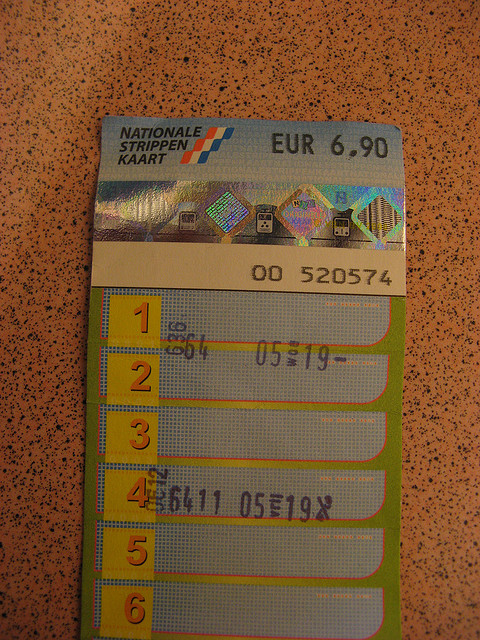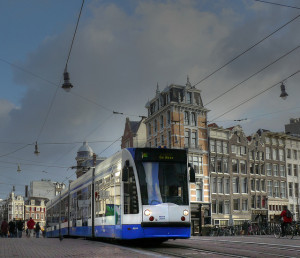bus and tram card [noun] [de strippenkaart, de strippenkaarten]
 Literally: “strips card” / “card with strips”.
Literally: “strips card” / “card with strips”.
(Note: text below no longer current due to introduction of OV-chip card.)
In the Dutch public transportation system, a certain card is in use with so called “strippen” (“strips”). These have to be stamped when travelling by bus, tram or metro.
This so called “strippenkaart” can be bought at several locations: at the ticket office of the Dutch railroads, at the ticket office of the local tramcompany, at the Albert Heijn and at the post office.
Two kinds of “strippenkaarten” exist: the blue “strippenkaart” for ‘normal’ users, and there’s the pink “strippenkaart” for users in the ‘discount categories’ (elderly people (65+), students, little children).
“Strippenkaarten” – both blue and pink – come in two sizes: 15 strips and 45 strips. Using a “strippenkaart” is cheaper than buying a separate ticket in bus or tram. A bus/tram subscription is nevertheless the cheapest…
(Photo: Tnarek Innael (flickr.com) – some rights reserved.)
Examples:
1. “Heb jij een strippenkaart? Anders moet ik een kaartje bij de trambestuurder kopen.”
(“Do you have a bus and tram card? Otherwise I have to buy a ticket from the tram driver.”)
2. “Mevrouw, u heeft niet voldoende strippen afgestempeld, ik ben bang dat we u een boete moeten geven.”
(“Madam, you have not stamped enough strips, I’m afraid that we’re going to have to give you a fine.”), see also ‘Extra’.
Related words:
1. “Openbaar vervoer” or “OV”: public transportation.
2. “Kaartje”: ticket (for a ride on the tram, literally: “little card”).
3. “Enkeltje”: one-way ticket (literally: “little single”).
4. “Retourtje”: return ticket (literally: “little return”).
Extra on “Stempelen” (“Stamping”): validating your strippenkaart
The number of strips that has to be stamped equals the number of public transportation zones that are travelled in, plus 1 (Dutch logic…). In a bus, stamping is done by the driver only. In the tram in The Hague, stamping is done by either the driver, or by oneself in the designated stamping machines. In Amsterdam stamping is often done by a designated person who sits in a cabin in the middle or back of the tram.
One who uses a “strippenkaart” for the first time, is advised to do this in the company of an experienced traveller 😉

 Literally: “strips card” / “card with strips”.
Literally: “strips card” / “card with strips”. The “tram” is a very common means of transportation in some of the bigger cities in The Netherlands. It is a vehicle, conducted through rails, for short distance transport of passengers, with a maximum speed of approximately 50 km/h.
The “tram” is a very common means of transportation in some of the bigger cities in The Netherlands. It is a vehicle, conducted through rails, for short distance transport of passengers, with a maximum speed of approximately 50 km/h.